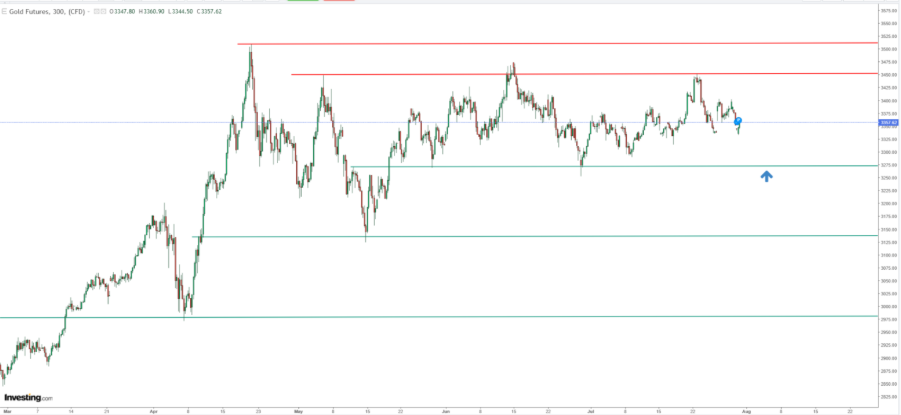As we navigate through the tumultuous currents of the global financial markets, all eyes have been riveted on the U.S. Federal Reserve’s latest move concerning interest rates. Amidst broad anticipation and not without a measure of controversy, the Fed has held its ground, opting to not lower interest rates. This decision comes despite conspicuous urging from U.S. President Donald Trump and vocal segments of domestic opposition, underscoring the central bank’s commitment to its independence and its assessment of prevailing economic conditions.
In the wake of this decision, the U.S. dollar has seen an appreciation, exerting additional pressure on various asset classes, with gold notably feeling the pinch. The resulting dynamics pose intriguing questions about the future trajectory of gold prices, especially if the dollar’s strength persists.
The unfolding saga takes a new twist with the eagerly awaited economic data set to be released on Friday. Should this data exceed market expectations, it would likely bolster the U.S. dollar further while simultaneously reinforcing the Federal Reserve’s current stance of caution. Such developments would have significant implications, not just for investors in currency markets but also for those keeping a close eye on precious metals.
On another front, the accumulation of gold reserves by central banks has been a noteworthy trend. Nations such as Kazakhstan, Turkey, and Poland have been particularly active in bolstering their gold holdings, a move that reflects broader dynamics within the global financial system and sentiments regarding economic stability.
### Gold’s Precarious Position and the Path Ahead
Following the Federal Reserve’s announcement, the immediate reaction in the gold market was sharp and decidedly bearish, with prices dropping significantly. This sudden movement has not only breached recent consolidation patterns but also ignited speculation about a potential retest of the $3200 support level. The market’s interpretation of the Fed’s message as hawkish—despite dissenting votes from board members Michelle Bowman and Christopher Waller, marking a historical divergence not seen in 30 years—adds layers of complexity to the narrative.
It’s important to recognize the broader context. The promising developments in U.S. trade agreements, reducing perceived market risks, and dampening the appeal of gold as a safe-haven asset, have also played a role in the current scenario. However, gold’s performance year-to-date, with a commendable 26% return in U.S. dollar terms, suggests that any pullback might be part of a normal correction within an ongoing upward trend. High prices have begun to affect demand in substantial markets, such as the jewelry sector in Asia, where anticipation of further price adjustments has tempered purchasing activities.
Several factors could influence gold’s market dynamics moving forward, including the Fed’s continued hawkish posture, geopolitical developments such as U.S.-led peace talks, and a stronger U.S. dollar buoyed by policy and geopolitical shifts. Yet, it’s crucial to remember that gold’s broader trajectory remains upward, indicating that recent declines might represent corrective phases within a larger bull market.
As market observers turn their attention towards measures like secondary sanctions on countries engaged in buying Russian oil, with the U.S. imposing significant tariffs on imports from nations like India, the intricate dance between geopolitical maneuvers and market reactions becomes all the more evident.
### Gold’s Market Dynamics: A Sideways Dance
Presently, gold prices seem to have found themselves in a phase of consolidation, oscillating within a defined range. This situation presents a potential setup for further downward movement, bringing the lower boundary of the current range into focus as a critical level. Conversely, a breakout above the upper threshold could negate the bearish outlook, potentially setting the stage for new highs.
In the midst of these developments, tools and resources aiming to aid investors in navigating these complex waters have gained prominence. Services like InvestingPro, with its array of analytical instruments, including ProPicks AI based on extensive financial data, the Fair Value model for stock valuation, and the WarrenAI for financial market analyses, have become invaluable for those seeking to make informed decisions.
### Conclusion
The tapestry of global financial markets is intricate and ever-changing. Factors ranging from central bank policies to geopolitical tensions weave together to create a dynamic environment where themes of caution and vigilance remain paramount. As we witness the unfolding narrative around gold prices and broader economic indicators, the importance of informed analysis and strategic foresight has never been more evident.
It is worth noting that all investments carry risks, and market conditions can change rapidly. Investors are advised to conduct thorough research and consider multiple perspectives before making investment decisions. The journey through the financial markets is fraught with challenges but also laden with opportunities for those prepared to navigate its complexities.


